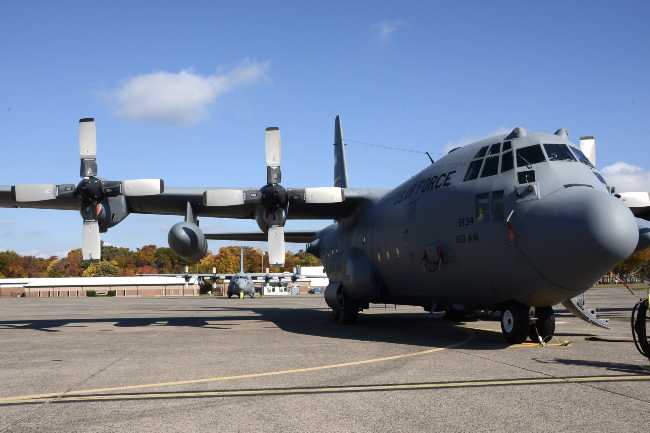
An Air National Guard C-130H assigned to the 103rd Airlift Wing is parked on the ramp at Bradley ANGB, Conn. ANG photo by MSgt. Erin McNamara.
The Air Force removed 60 C-130H aircraft from flying status last month as it replaced propellers built prior to 1971 that were prone to cracking, officials revealed during a recent congressional hearing.
All but five of the aircraft, which are undergoing previously scheduled maintenance, have since returned to flight, service spokeswoman Ann Stefanek told Air Force Magazine. Though most of the aircraft are flown by the Air National Guard, Stefanek said the H-models were spread throughout the fleet and rarely required entire units to stand down. However, she did note that six of the eight C-130s assigned to the Connecticut ANG’s 103rd Airlift Wing were affected.
Local maintainers were able to replace the propellers and, in most cases, quickly get the aircraft back in the air. They sometimes turned around aircraft in a single day.
The service started analyzing its C-130 propellers after 15 Marines and one sailor were killed when a Marine Corps KC-130T crashed in Mississippi in 2017. An accident investigation found an Air Force depot failed to fix a corroded blade back in 2011 when the aircraft went in for maintenance, allowing the problem to turn into a crack that went undetected for years.
“We put safety first. We’re focused on that very much, and we’re working very carefully with all the affected parties to make sure we understand exactly where we are on this issue and that we’re moving out rapidly to address it and correct,” Lt. Gen. Timothy Fay, USAF deputy chief of staff for strategy, integration, and requirements, told the House Armed Services seapower and projection forces subcommittee March 14.
Fay said the service inspected 1,500 blades “almost immediately,” and found “two that were of interest.” Of those two, “one was found to be … suspect and we addressed that right away.”
The service also dug through decades of data and discovered there were two types of propellers on the H-model fleet—those created largely through a manual manufacturing process prior to 1971, which were deemed unsafe to fly, and the post-1971 blades created with an automated manufacturing process.
The Air Force has a total of 230 C-130s in its fleet, including its LC-130s with skis and those equipped with the Modular Airborne Fire Fighting System, Stefanek said.
“We replaced the old ones with new four-bladed propellers. That’s the short-term fix. Now the discussion is the long-term fix,” Maj. Gen. Marc Sasseville, deputy director of the Air National Guard, told Air Force Magazine. “At some point, the post-1971 blades will fly out as well. We’ve been flying the same engine for almost 50 years.”
The Air Force already has upgraded the New York Air National Guard’s small fleet of LC-130H aircraft with more efficient eight-blade propellers, and it is in the process of upgrading the MAFFS-equipped aircraft with the same blades.
Six LC-130s from the New York ANG’s 109th Airlift Wing recently returned from a five-month deployment to Antarctica in support of Operation Deep Freeze. It was the first time all of the ski-equipped aircraft operated with the eight-blade NP-2000 propeller, which offer more power and range, have better fuel efficiency, and are more reliable than the older four-bladed system.
“The new propellers provide more power at lower speeds,” Lt. Col. Steven Slosek, an LC-130 navigator, said in a release. “This eliminates the need for assisted takeoffs on unprepared or soft snow. It also allows for just one blade to be replaced when needed, instead of having to replace all the blades at once.”
Previously, the 109th had to use jet-assisted take-off devices in some instances, which stressed the airframe and decreased aircraft life, according to the release.
Sasseville said the Guard hopes to eventually retrofit the rest of the H-model fleet with the eight-bladed propeller “if we can figure out how to pay for it.”
The service also in the process of modifying the H-models with two other propulsion system upgrades—the electronic propeller control system enables the aircraft to be more responsive when crews rapidly advance the throttle, and the Rolls Royce T56-series 3.5 engines are more fuel-efficient and reliable.
In addition, the Guard is working to meet a Federal Aviation Administration mandate to upgrade its C-130H communications, navigation, and surveillance/air traffic management systems. After the service cancelled the C-130 Avionics Modernization Program program in 2012 due to sequestration cuts, it relaunched the program in 2016 in two phases, dubbing it AMP I and AMP II. The first increment is fully funded and is slated to be complete by the end of 2019 in order to meet the 2020 FAA mandate.
Guard officials told Air Force Magazine they “remain hopeful” the service can meet that timeline, but if not, the service may seek a waiver that would allow the H-models that still need upgrades to continue flying after Jan. 1, 2020. The aircraft are expected to fly into the 2040s.
AMP II is much more expensive and complicated, and it won’t begin until AMP I is complete. It will essentially replace all the analog avionics in the front end of the aircraft with new digital systems, Col. Dan Begin, deputy director of the National Guard Bureau’s plans and requirements office, told Air Force Magazine.
Congress previously dictated that AMP II should reach full-rate production no later than the end of 2028, he added.
“Since we’re mostly H-models [in the ANG], the name of the game is modernization,” Sasseville said, though he noted that finding the money is still a challenge.